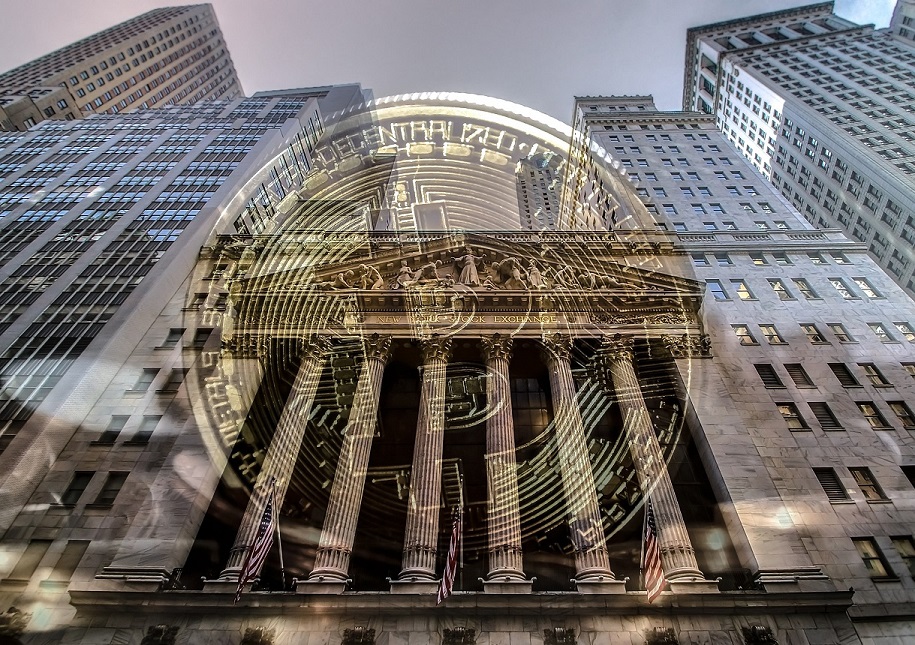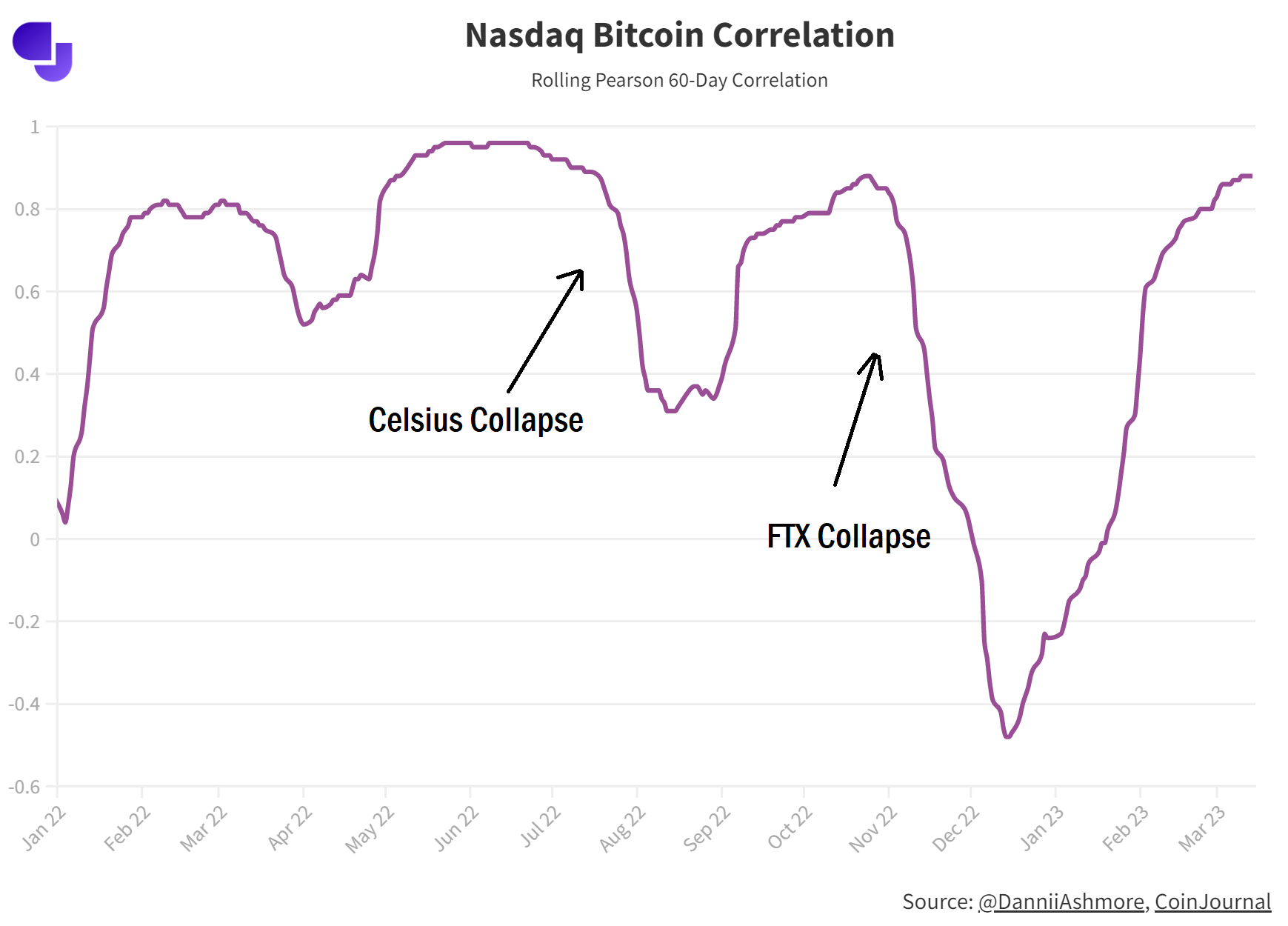No, Bitcoin is still as correlated as ever with the stock market

Important takeaways
- Bitcoin’s recent rise has caused surprise as the banking sector has dragged down the stock market
- Declaring this a break in the correlation trend is a mistake, writes our data analyst Dan Ashmore, who says that Bitcoin remains risky.
- Both the stock market and Bitcoin continue to weigh on interest rate expectations, apart from isolated episodes of systemic risk for Bitcoin, the figures show
- The last week shows a slightly softer relationship than normal, corresponding to a less dramatic and less dramatic version of the price action around the 2022 FTX and Celsius collapses
- Normal correlation must soon resume, our data shows
One of the dominant stories of the last year or two has been the incredibly close relationship between Bitcoin and the stock market.
We’ll get into the numbers soon, but the mantra is that when the stock market jumps, Bitcoin jumps more. When the stock market falls, Bitcoin falls more. That’s the bottom line. But is it still true?
Some market participants are beginning to believe that this relationship is changing, especially given the events of the past week. The word “uncorrelated” is being tossed around a lot in the markets, and now some say Bitcoin is making progress towards that status. I’m not so sure that’s right.
The correlation has been high since 2022 started
Let’s first look back at the price action from the start of 2022, which more or less marked the stock market peak.
I’ll go into more depth in the next section, but the best way to start an assessment of correlation is with the old-fashioned eye test. Let’s begin by charting Bitcoin’s return against the Nasdaq since the start of 2022:
It is immediately clear that there is a strong pattern here.
Before we look at correlation coefficients, by looking at the respective price action we can see that the assets have been in lock step except for two (visually notable) periods. The first is August 2022, when Bitcoin lagged the Nasdaq’s gains. It still outperformed, but it outperformed the Nasdaq – unusual in periods of expansion. This was shortly after the infection crisis triggered by Celsius (it filed for bankruptcy in mid-July).
The second period of divergence that jumps out is a much more noticeable one – November 2022. As the Nasdaq rallied from softer inflation readings and optimism on interest rate policy, Bitcoin fell. Not only that, but it dropped dramatically, down from $20,000 to $15,000. Of course this was thanks to Sam Bankman-Fried and FTX collapsea bearish shock specific to crypto, much like Celsius was.
Now let’s draw the correlation itself. I won’t go too deep into the math, but I’ve used the 60-day Pearson indicator and rolled it back to early 2022.
The results more or less support what we discussed above. For the uninitiated, a correlation of 1 means a perfect relationship (the word count of this article and the number of words I’ve written this month, for example) while a correlation of 0 means no relationship (like my word count per month and the number of T-Rexes spotted in New York City).
Celsius and FTX collapses are clear below, while the second decline occurs around the time of LUNA (the stock market also fell around this time when we moved to high interest policy).

Correlation can be misleading
This shows correlation, but not necessarily causation. My old math teacher had a great way of explaining this difference. Shark bites and ice cream purchases may be related, but no one would argue that digging into Ben and Jerry’s makes you more likely to be chased by a great white shark.
Instead, there is one lurking variable. In this case, on sunnier days, people are more likely to both swim at the beach and buy ice cream, and it is the swimming rather than the ice that makes a shark bite more likely. Swimming is lurking variable.
While that example is exaggerated (shark bites are extremely rare, in case I develop a phobia for you!), the point is good. In the financial markets, we have another lurking variable. In truth, we have many of them—there are an imaginable number of variables that affect the stock market—but the big one over the past year has been the Federal Reserve and its interest rate policy.
It is not the stock market that makes Bitcoin move, it is interest rate policy that makes both the stock market and Bitcoin move. And in turn, expectations of inflation have been the key factor that has led to interest rate expectations. This is why we have repeatedly seen big moves around CPI announcements and Fed meetings.
There is a saying: “Correlations of risk assets go to 1 in times of crisis”. And when we moved to a new interest rate paradigm in April 2022, when it became clear that inflation was rampant, that’s exactly what happened.
All risk assets were sold, including both stocks and shares. Bitcoin, being more volatile, of course sold more. And since then, apart from the aforementioned episodes, the connection has remained.
Is the correlation falling?
The big question is whether this correlation falls. It is actually the ultimate vision for Bitcoin. An uncorrelated store of value, akin to a digital form of gold.
Some have looked at price action over the past week or two and declared that this means we are seeing a lower correlation. But I think this is simply a smaller version of what we saw during the Celsius and FTX “disconnects”. A short-term decrease in correlation in response to a specific event.
Bitcoin sold off drastically in the wake of the problems with Silicon Valley Bank (SVB), before recovering sharply when the US administration announced that it was stepping in to guarantee deposits.
The stock market, on the other hand, also sold off, but to a much lesser extent. And so with the banking crisis hitting Europe yesterday, Bitcoin held firm as markets wobbled. The statement was that this must mean that the famous disconnection is taking place.
I think this is a fallacy and I think the numbers match.
Bitcoin was initially sold aggressively because SVB had the potential to be a crisis on the scale of Celsius and FTX, as Circle, the issuer of the world’s second largest stablecoin, USDC, has $3.3 billion in reserves in the bank (and the original fear) . was that it may last longer, before the number was clarified).
USDC was thus depegged, and fell below 90 cents on many exchanges. Obviously, a USDC collapse would be harrowing for the industry and thus Bitcoin plummeted and fell to around $20,000.
While the SVB presented an ominous threat to the financial markets as a whole, the danger within cryptocurrency was heightened due to the importance of the USDC to the industry, especially after the shutdown of the BUSD last month.
With 25% of Circle’s reserves in cash, there were fears of insolvency until it was clarified that only 8.25% of reserves were held in SVB, before the US administration stepped in to guarantee deposits anyway.
Once this fear was over, Bitcoin recovered, reversing its fall as the crisis came into view. But the shares did not jump to the same extent. This makes sense.
Also, the price action was not that dramatic, and the supposed “disconnection” was unlikely to be drastic. European banks were hit on Wednesday, but Thursday has largely seen an upswing, while the stock market is generally doing well, showing moderate gains.
Looking at the correlation calculation, it has barely moved over a longer time frame like 60-days, and is already on its way back. The 30-day metric shows more movement, but as with any smaller sample size, it is always more volatile and less indicative. Both metrics already seem to be coming back anyway.
Whichever way you swing it, a simple glance at the aforementioned chart comparing the Nasdaq to Bitcoin is all you need to know. Bitcoin is traded as an extreme risk asset and that is quite clear.
The trillion dollar question is whether this will change in the future. Can Bitcoin finally disconnect from risky assets and establish itself as an uncorrelated store of value? Can it become a real means of protection?
It may happen one day. But that hasn’t happened yet.

